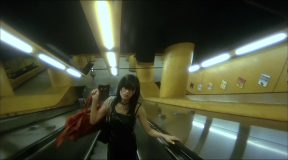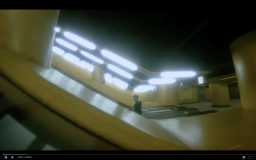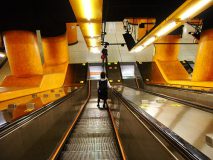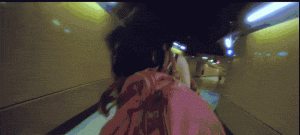FALLEN ANGELS, DIR. WONG KAR WAI (1995)
Sai Wan Ho Station, Eastern District, Hong Kong

‘Partner’ travelling in Sai Wan Ho station. With an extreme wide angle view, a huge space in the station area is portrayed . The emptiness around her is emphasised while there is no one in this huge station.
Depicts the loneliness and nihilism of people during the explosion of rapid urbanisation in Hong Kong, the film Fallen Angels [1] tells two story lines. Hitman Wong Chi-ming unaware of the infatuation of his business partner, he was being tired of his emotionless job and he decided to terminate the business relationship with the ‘partner’, which made her devastated and decided to assassinate her lover in their last operation in order to retain their relationship. Meanwhile another character Ho Chi Mo who is a mute, always forces others to do business with him, and even stomps into the closed stalls to play as the stall owner so that he can make ‘interaction’ with people, as he seems to be a nut to ordinary people in real life. He fell in love with a woman Charlie who cannot pull herself from her previous relationship. The characters all seem to be psychos comparing to our real life, but they are actually the projections of many modern people in this concrete city, whom feel detached from emotional interaction even though city’s transformation has made more spaces for them to interact. The film composed of many shots of the characters travelling in the city through MTR and driving motorcycles in the underground tunnels. Just before the film was published, Hong Kong was undergoing large scale urban renewal including the opening of Island Line in MTR, which serves a main space for commutation for the characters.

Hitman Wong travelling on the escalator to the concourse, the hallow and dark space swallows his tiny silhouette.

In real life, mass flow of people use MTR as their main transportation medium, which makes MTR known for its crowdedness and hectic environment.
Sai Wan Ho station in the film is portrayed as a huge hallow space with brutalist infrastructures, while the characters are being the travels on through the space alone. Compared to real life, Sai Wan Ho station is actually a relatively busy transportation platform where many people travel on the structured routes to get to their destinations. In the movie, the filter has made the facade of the infrastructure and lightings dull and cold. Even though there are light tubes above, the light is being diffused in the film which makes the atmosphere gloomy. While in contrast, the reality is the opposite as the facades are painted with bright energetic yellow. The characters travel as ‘voyeur’ in the station as we can see they occupies the whole space during their commutation and walk alone, the narration goes to them as they voice over their feelings in the film, which shows their detachment from the space. While in reality, people are the ‘flaneur’ who are part of the crowd and engaging in daily activities. [2] The void created in the film represents the disappearance of intimacy between people at spiritual level, which cannot be shown in reality while there are mass flow of people passing by everyday in the station. [3]

‘Partner’ travelling in the tunnel of Sai Wan Ho station, with nothing but a void around her.
In the movie shots, an extreme wide angle view is used when portraying the characters movement. The Sai Wan Ho station is the ‘place’ where hitman Wong and ‘partner’ would travel in the same route but in different time, so that they never meet in person during business. The station as a ‘place’ represents the similar living styles and loneliness of both. While as a ‘space’, both characters keep distance from each other and never get to the intimacy due to different timeline. This ironically portrays the characters’ strong crave for close contact with people but never try to involve other’s emotions, which make them miserably lonely. [4] Moreover, the unusual emptiness of the space surrounding them emphasise the detachment of the characters from society, that they do not interact with people but only express their feelings with voice overs. The strong contrast reflects the theme ‘loneliness’, and their unwillingness to make contact with people. ‘There are some people you can never get close to, if you get too close you will find him boring’ ‘Partner’ says, hiding her infatuation in her own imagination instead of expressing in real world. All the main characters are lonely ‘voyeur’ who create their satisfaction in their imagination, which creates a thick layer of gap from the real world. And the travelling scenes of hitman Wong and ‘Partner’ in Sai Wan Ho station are the best portraits of their borderline personalities, they are all inside their own worlds.
— Jeannie Qin 3035932678
Notes:
1. Fallen Angels is a 1995 Hong Kong romantic crime comedy-drama film written and directed by Wong Kar-wai, starring Leon Lai, Michelle Reis, Takeshi Kaneshiro, Charlie Yeung, and Karen Mok.
2. AlSayyad, N. (2006). Voyeuristic Modernity: the Lens, the Screen and the City. In Cinematic urbanism: A history of the modern from reel to real (pp. 147-168). New York: London: Routledge.
3. Abbas, M. A. (1997). Hong Kong: Culture and the politics of disappearance (pp. 63-90). Hong Kong: Hong Kong University Press.
4. De Certeau, M. (1984). Spatial Stories. In The Practice of Everyday Life (pp. 115-130), translated by Steven Randall. Berkeley: University of California Press.
I appreciate that you have utilized multiple concepts from the class to understand how the spaces appeared in the film. You may have picked one or two concepts to delve deeper into. For instance, the concept of disappearance does not only mean physical disappearance only. it is also an emotion that is attached to the contingency of the city. How do you understand such disappearance of people in the film in relation to this? Moreover, you may take more photos of the MTR station during its peak hour to better contrast with the emptiness displayed in the film.